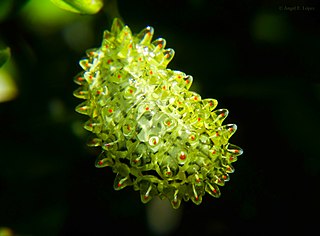Oroya aurora is a moth in the family Dalceridae, and the only species in the genus Oroya. Both the genus and the species were first described by Scott E. Miller in 1994. It is found in southern Peru and adjacent Bolivia. The habitat consists of tropical premontane wet, tropical premontane moist and subtropical (lower) montane wet forests.
Acraga goes is a moth of the family Dalceridae. It is found in Costa Rica, Ecuador, Venezuela, Trinidad, Guyana, Suriname, French Guiana, Colombia, Peru and Brazil. The habitat consists of tropical wet, tropical moist, tropical dry, tropical premontane wet, tropical premontane moist and subtropical dry forests.
Acraga andina is a moth of the family Dalceridae. It is found in Andes Mountains of Venezuela, Colombia, Ecuador and Peru. The habitat consists of tropical wet, tropical premontane wet, tropical premontane moist and probably tropical montane wet forests.
Acraga flava is a moth of the family Dalceridae. It is found in southern Brazil and northern Argentina. The habitat consists of tropical premontane moist, subtropical wet, subtropical moist, subtropical lower montane wet, subtropical lower montane moist and warm temperate moist forests.
Acraga neblina is a moth of the family Dalceridae. It is found in Venezuela. The habitat consists of tropical premontane wet and tropical lower montane rain forests, where it is found at high altitudes.

Acraga moorei, the tangerine furry-legs, is a moth of the family Dalceridae. It is found in Venezuela, Colombia, Brazil, Ecuador, Peru, Bolivia, Paraguay and northern Argentina. The habitat consists of tropical wet, tropical moist, tropical premontane wet, tropical premontane moist, tropical lower montane wet, tropical lower montane moist, subtropical wet, subtropical moist, subtropical lower montane moist, subtropical montane wet or rain and warm temperate moist forests.

Acraga coa is a moth of the family Dalceridae. It is found in southern Mexico, Belize, Honduras, Guatemala, El Salvador, Costa Rica and Panama. The habitat consists of tropical wet, tropical moist, tropical premontane wet, tropical premontane rain, tropical lower montane moist, subtropical wet, subtropical moist, subtropical dry and warm temperate wet forests.
Acraga concolor is a moth from the family Dalceridae. It is found in Venezuela, Suriname, French Guiana, northern Brazil, Ecuador, Peru and Bolivia. The habitat consists of tropical moist, tropical wet, tropical premontane rain, tropical premontane wet and subtropical moist forests.
Acraga citrinopsis is a moth of the family Dalceridae. It is found in Venezuela, Brazil, Peru and Bolivia. The habitat consists of tropical moist, tropical dry, tropical premontane moist, subtropical moist and warm temperate moist or dry forests.
Acraga meridensis is a moth of the family Dalceridae. It is found in the Andes Mountains of Venezuela and Colombia. The habitat probably consists of tropical premontane and lower montane moist or wet forests.
Acraga mariala is a moth of the family Dalceridae. It is found in Colombia. The habitat consists of tropical lower montane or premontane wet and tropical lower montane moist forests.
Acraga perbrunnea is a moth of the family Dalceridae. It is found in Colombia and Peru. The habitat consists of tropical lower montane moist and tropical premontane wet forests.
Acraga hoppiana is a moth of the family Dalceridae. It is found in Colombia and Ecuador. The habitat consists of tropical wet, Tropical lower montane dry and possibly in tropical premontane rain forests.
Dalcerides sofia is a moth in the family Dalceridae. It was described by Harrison Gray Dyar Jr. in 1910. It is found in southern Mexico, Guatemala, El Salvador, Nicaragua and Costa Rica. The habitat consists of tropical moist, tropical dry, tropical premontane wet, subtropical moist, subtropical dry and warm temperate wet forests.
Dalcerides mesoa is a moth in the family Dalceridae. It was described by Herbert Druce in 1887. It is found in southern Mexico, Guatemala, Costa Rica, Panama, Colombia, Venezuela and Ecuador. The habitat consists of tropical wet, tropical moist, tropical dry, tropical premontane wet, tropical premontane rain, subtropical wet and subtropical dry forests.
Dalcerides ingenita is a moth in the family Dalceridae. It was described by Henry Edwards in 1882. It is found in the US from southeastern Arizona, north through the mountains to Flagstaff. It is also found in southwestern Texas and Mexico. The habitat consists of subtropical moist, subtropical dry, warm temperate moist and warm temperate dry forests, as well as warm temperate thorn steppe.
Dalcerides flavetta is a moth in the family Dalceridae. It was described by Schaus in 1905. It is found in Venezuela, Guyana, Suriname, French Guiana, Colombia, Ecuador, Peru, Bolivia and northern Brazil. The habitat consists of tropical wet, tropical moist, tropical premontane wet, tropical premontane moist, subtropical moist and tropical dry forests.
Minacraga disconitens is a moth in the family Dalceridae. It was described by Schaus in 1905. It is found in Venezuela, Trinidad, Guyana, Suriname, French Guiana, Brazil, eastern Peru and Bolivia. The habitat consists of tropical moist, tropical premontane wet, tropical premontane moist, subtropical moist and warm temperate moist or dry forests.
Paracraga argentea is a moth in the family Dalceridae. It was described by Schaus in 1910. It is found in Mexico, Honduras, Belize, Guatemala, El Salvador, Costa Rica and Panama. The habitat consists of tropical wet, tropical moist, tropical premontane wet, tropical premontane moist, subtropical wet subtropical moist forests.
Minacraga itatiaia is a moth in the family Dalceridae. It was described by S.E. Miller in 1994. It is found in southern Brazil. The habitat consists of subtropical wet, subtropical lower montane moist and warm temperate moist forests.


